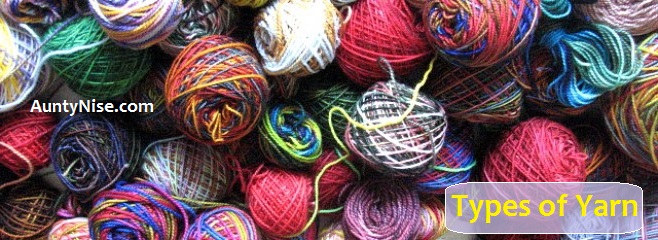Before you start knitting, there are some things you may want to know. Lets start with the different types of yarn for your knitting or crochet.

Types of Yarn for Knitting
There are so many different types of Yarn and it can be quite overwhelming as a new Knitter or Crocheter. Different type of fibres and yarn will come out with completely different looks/textures/sizes of your piece or garment. Familiarise yourself with the different kinds of yarn fibre and how they will work in a knitting or crochet project, before buying your next ball of yarn.
Synthetic Fibres:
Nylon, rayon, acrylic, viscose, and polyester are all synthetic fibres that appear in yarn. 100 % acrylic yarn is a common choice as it is the most affordable yarn. So if you’re just learning or starting out, acrylic yarn a good choice.
Blends:
Many yarns blend different natural fibres, synthetic fibres or natural fibres with synthetic fibres, such as for a softer feel. If you going to be felting your knitted or crochet project, you need ensure the yarn is at least 80% wool, but the other 20% can be synthetic.
Natural Fibres Cotton:
Made from cotton plants, many types of cotton yarn are treated with chemicals to make them more durable, mildew resistant, and able to accept dyes better.
Alpaca/Llama: South American llamas or alpacas produce very soft, warm yarn. Llama wool yarn is less soft and bulkier. Alpaca and llama wool is a great hyper-allergenic fibre, since it does not have the lanolin which is found in lamb’s wool.
Angora: Angora is an especially soft rabbit fur yarn that has a fuzzy appearance.
Cashmere: Cashmere, from the soft undercoats of cashmere goats. It is more expensive yarn but is especially smooth while still retaining warmth.
Linen: Linen yarn is made from the flax plant. It is lightweight and perfect for summer garments.
Mohair: Mohair is a thick yarn from the Angora goat and has an especially fuzzy look.
Silk: Silk comes from silkworm larvae. It is very smooth and light. As silk does not have much stretch, it is commonly combined with other fibres for yarn, often cashmere.
Wool: Many different kinds of wool exist and are spun into yarns with different weights and textures. Wool accepts colour very well and is very warm. Merino wool yarn is a popular choice in making garments.
Eco-Friendly Yarns:
Bamboo: Bamboo yarn has the feel of silk and is very strong. Bamboo is a renewable resource because it can be harvested without killing the plant, which then regenerates the removed bamboo in a couple of months.
Hemp: Hemp is another renewable resource which can be grown without pesticides or herbicides and is the strongest natural fibre. Hemp yarn garments are softer with each machine washing and can be treated for softness as yarn.
Reading Yarn Labels
Do you need help reading and understand a yarn label?

1. Yarn Weight: Yarn is divided by its weight, or how many stitches in a gauge of 4 inches (10cm). The thinner the yarn, the more stitches in the gauge. For more of an explanation of Yarn Weights, check out my page on this specifically, here.
2. and 3. Knitting & Crochet Gauge: For Knitting and Crochet, the gauge means the same thing. How many stitches by the amount of rows, will fit into a 4×4″ or 10x10cm square (swatch). This is a guide for you to compare yourself to, if you are using the same needles or hook that they are showing on the label. Everyone’s knitting/crochet has a different tension (some crafters have tighter stitches and some have looser stitches, which effects your OWN gauge and swatch).
This is why, whenever you start a new brand new project or use a yarn that you’ve never used before and following a pattern, you need to make your own swatch. This is because you may need to use few or more stitches per row, than what it actually says on the label. Sometimes if you’re creating a piece of clothing, it may be too big or too small, even though you’re following a pattern, just because of your tightness or looseness of your stitches (your tension is different from what the pattern states). Hope that wasn’t too confusing 🙂
4-8. Are your Care instructions. Sometimes these do not have pictures, but have the actual words. But I have shown the pictures just incase you come across them and have no idea what each of them mean. So these 5 pictures are;
4. Washing Instructions: This label states that the yarn (finished item) be Hand Washed at 86°F or 30°C
5. Drying Instructions: The symbol of a square with a line in the middle tells you to let the item dry flat, once washed.
6. Bleaching Instructions: This Triangle symbol is referring to bleaching. In this symbol, it’s basically saying a big No! These yarns are dyed and you don’t want to destroy the colour.
7. Ironing Instructions: This basically is an Iron symbol with a cross on it, again meaning, big No-No. However, this is referring to direct contact with the finished item. Sometimes you need to “block” your work, or flatten it out because it is curling. This does use an iron, but water is first lightly sprayed onto your work and the iron only hovers over the work, not actually touches it.
8. Dry-cleaning Instructions: This circle resembles dry-cleaning and is also not recommended for this yarn, on this label. Bleaching, Ironing and Dry-cleaning are generally a No-No on labels for yarns.
